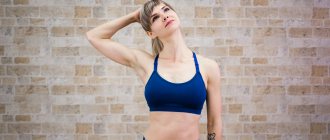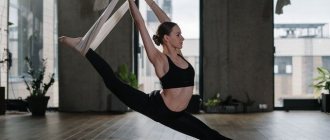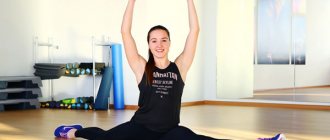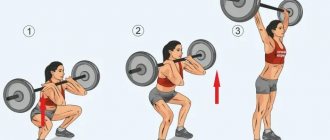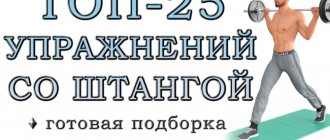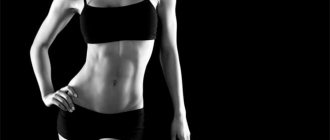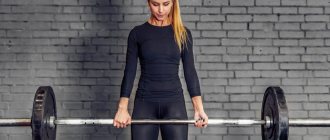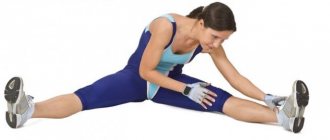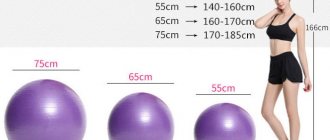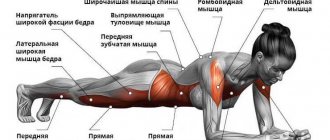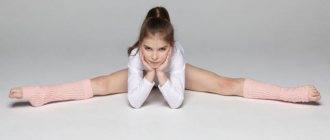Stretching exercises improve muscle recovery after strength training. They are an essential part of a weight loss, health, or strength training plan. Athletes, dancers and ordinary office workers need to stretch their muscles. Physical inactivity, unnatural posture when working at a computer, “walking” while sitting in a car - all this strengthens muscles, deprives joints of a natural range of motion and requires a person to include stretching exercises in the training program. You can stretch every time after strength training or cardio, devoting 30 seconds to the main muscle groups, or you can do stretching training on one day. For beginners, exercises are shown in a natural amplitude, without “springs” and pushing the body into a pose through pain. You can perform these movements at home yourself.
Warm up before stretching
When you stretch after a workout, your muscles are already warmed up and no additional warm-up is required. If you decide to arrange a separate stretching lesson, first do a few exercises:
- Joint warm-up: twirl your joints, bend and twist your body.
- 5-7 minutes of cardio: running or Jumping Jacks, Rock Climber, running in place with high knees, jumping rope.
Once you've warmed up a bit, you can start stretching.
Features of stretching
Stretching can be done either in groups with a trainer or independently. The main thing is to learn the correct technique for performing all exercises and not get injured. To do this, you need to remember a few rules.
- The purpose of the warm-up is to prepare the joints and muscles. A high-quality warm-up will help not only reduce the risk of injury, but also make the stretching itself painless and comfortable;
- Breathing affects the muscles' access to nutrients and oxygen. When you hold your breath, muscle tension increases, which definitely cannot be useful during stretching;
- Regularity . It is much better to spend about 20 minutes stretching every day rather than spend an hour several times a week hoping for instant results. Intensity without regularity results in slower progress;
- Don't overload or overstretch the same muscle group. “Clogged” muscles will, on the contrary, return to their original shape.
How and how much to stretch
With these exercises, you can arrange an independent stretching session and thoroughly stretch all the muscles of your body. However, it will take about 60–90 minutes. For a quick stretch, choose one or two exercises for each muscle group involved in the workout.
To give your muscles a good stretch, hold each pose for 30 seconds to two minutes. You can remain still or gently spring. Sudden movements can cause injury, so leave them for another sport.
We will give exercises for stretching from top to bottom: neck, shoulders and arms, chest and back, abs, buttocks, thighs, legs.
How to stretch correctly
Before you tell us what stretching exercises there are, read what you need to keep in mind so as not to harm yourself:
- Warm-up - you can’t go anywhere without it, and don’t even think that you can be free here. Read more about warm-up exercises here.
- Work incrementally to strengthen the result.
- Think about what you are doing so as not to miss any important muscles. You need to know which muscles are involved during a particular stretching exercise.
- Safety is everything. If you feel a sharp, unpleasant pain while performing movements, you need to stop and correct your technique.
Neck stretching exercises
Tilt of the head back and to the side
Tilt your head back, stretching the front of your neck. From this position, tilt your head to the left. For greater effect, place your left palm on the right side of your head, but do not press hard.
Repeat the exercise on the other side.
Head tilt forward and sideways
Place your right hand on the left side of your head. Tilt your head forward and to the side, increase the pressure with your hand.
Repeat on the other side.
Back of the neck stretch
Place one hand on the back of your head and the other on your chin. Lower your head, making a double chin. At the same time, the neck remains straight, the back of the head tends upward. You should feel tension in the back of your neck, especially at the base of your skull.
Why do you need stretching?
In short, stretching is the only chance for the body to compensate for all the overloads and axial loads that we experience during strength work and everyday activity. Only during stretching do the joints not experience compression, which is the best prevention of inflammation. In addition, stretching improves mobility in everyday life and relieves pain.
The advantages of stretching are:
- Relieves muscle stiffness, gives the opportunity to move freely;
- Helps with plasticity and grace even for those who have obvious problems;
- Improves mobility in joints;
- Helps you perform strength exercises with the correct technique;
- Provides muscles with blood and oxygen for recovery;
- Relaxes the central nervous system;
- Strengthens ligaments and neuromuscular connections;
- Works with coordination of movements;
- Helps you move more smoothly and accurately in dance and martial arts;
- Corrects postural imbalances
Shoulder stretches
Front Shoulder Stretch
Place your hands behind your back, clasp your wrist with one hand and the other. Bend your elbows and lift your wrists higher. Push your chest forward and feel the stretch in the front of your shoulders.
Mid Shoulder Stretch
Grab your opposite elbow with your hand, press your shoulder towards you and pull it down. Repeat with the other hand.
Back Shoulder Stretch
Grasp your right arm with your left above the elbow, press it to your body and straighten it, lower your right shoulder down. With your left hand, pull your right hand up, lifting it with your elbow. Feel the tension in the back of your shoulders.
Repeat with the other hand.
Triceps stretch
Go to the wall, lift your left elbow up, and place your forearm behind your back. Lower your left shoulder blade down. To check that it has actually dropped and will not rise during the stretch, place your right hand below your left armpit.
Repeat on the other side.
Biceps stretch
Grab a doorknob, counter, or other support and turn your back to it. Turn your elbow upward and move your body slightly forward.
Repeat with the other hand.
Triceps and Shoulder Stretch
This pose allows you to simultaneously stretch the triceps of one arm and the front of the shoulder of the other. Place one hand behind your back from above so that your elbow points upward, and the other from below so that your elbow points to the floor. Try to bring your wrists together behind your back at the level of your shoulder blades.
Switch hands.
Wrist Extensor Stretch
Sit on your knees, place your hands in front of you so that the backs of your hands touch the floor and your fingers point towards each other. Gently shift your weight into your hands, stretching your forearms. To enhance the effect, try clenching your fists.
Stretching and flexibility training program
By improving your flexibility, you will improve your athletic performance. If you have an inactive lifestyle, then by stretching you will significantly improve your physical condition and speed up your metabolism. To improve your progress in stretching, perform it not only before and after training, but also as a separate complex:
- Start the complex from the neck: Perform 4-5 head rotations in both directions while standing.
- Perform head turns 4-5 times in each direction.
- Touch your chin to your chest, then lift your chin up 4-5 times.
- Spread your hands to the sides, clench them into fists and perform rotational movements with your fists in different directions several times
- Stretch your arms and shoulders against the wall by pressing your hands against the wall and arching your back down. Repeat 2-3 times for 10 seconds.
- Perform cross forward leg raises 10–15 times with each leg in 2–3 approaches.
Chest stretching exercises
Chest stretch in the doorway
Approach the doorway, lean your elbows on the doorframes and push your chest forward, stretching your pectoral muscles.
Wall Chest Stretch
Place your hand on the wall, lower your shoulder and turn in the opposite direction. Repeat with the other hand.
Stretching. Exercises for the elderly and more. Basic Rules
Before stretching, you need to warm up . For older people who are simply not very flexible, you can perform light joint exercises, starting from the neck and gradually moving down. For those who have limited joint mobility, you can warm up a little by running or jumping in place.
“Try to hold each position for about 8 seconds. If this is difficult, then start at a time that is comfortable for you, says Irina Klimova. “You shouldn’t experience pain during the exercise, but there should definitely be a feeling of stretching.” Watch your breathing and try to increase the amplitude as you exhale.
Attention! Before starting the daily implementation of the complex, elderly people and people with musculoskeletal problems should consult a doctor.
Back stretching exercises
Back stretch at the counter
Stand next to a rack, exercise machine or other support, turn your left shoulder towards it. With your right hand, grab the rack high above your head and move your pelvis to the right and down, stretching the entire right side of your body.
Repeat on the other side.
Stretching the lower back muscles
Sit on the floor, move your right leg forward, left leg back. Bend your knees at an angle of 90 degrees or slightly more. Place your right hand on the floor, raise your left above your head. Pull your left leg down and back, tilt your body forward and twist towards your right leg.
Switch legs.
Back extensor stretch
Sit on the floor, bend your knees and place your feet on the floor. Grasp your shins with your hands on the inside, place your wrists on your feet. Bend forward with a round back as low as possible.
Child's pose
Sit on the floor, buttocks should touch your heels. Lean forward, lie on your stomach on your knees and extend your arms.
Downward Facing Dog Pose
Get on all fours, then move your pelvis back and up so that your body resembles an angle. Your arms and back should be stretched out in one line, your knees can be bent, and your heels can be lifted off the floor. The main thing is that your back remains straight, without rounding in the lower back.
Hanging traction
Grab a low horizontal bar and hang freely, relaxing your body. Feet should remain on the ground. Relax them, bend your knees slightly.
Inverted back stretch
Lie on the floor on your back, arms along your body, legs straight. Raise your legs and then throw them behind your head. Hands rest with elbows on the floor, hands support the lower back. Do not lean on your neck, the fulcrum is your shoulders.
Video collection with sets of stretching exercises
There are many different complexes for stretching the muscles of the whole body; below is a video selection.
Stretching for women based on yoga exercises,
stretching for beginners with zero level of training,
stretching for those involved in combat sports.
Video: Stretching for women in 20 minutes
This complex is based on yoga asanas (postures).
Video: Stretching complex for beginners
If you have zero level of training, start training with this video.
Abdominal stretching exercises
Camel Pose
Get on your knees, push your chest up, lengthening your spine, and then lean back, placing your hands on your heels. Try to bend in the thoracic region. Don't throw your head back, look up.
Upward-facing dog pose
Lie on the floor on your stomach, place your hands under your shoulders. Push yourself up, your pelvis rises, your legs remain on the floor. Lower your shoulders, bend in the chest.
Standing Backbend
Stand straight with your feet together. Raise your arms and join your palms above your head. Bend your chest and tilt your body back. Tighten your buttocks to prevent a strong arch in your lower back.
Side tilt
Stand up straight, raise your arms above your head, clasp your fingers and turn your palms up. Stretch up and bend first to one side and then to the other.
Lying spinal twist
Lie on the floor on your back, arms out to the sides, palms down. Move your pelvis to the left, lift your left leg, bending it at the knee, move it behind your right leg and try to place your knee on the floor. Turn your head to the left and relax.
Repeat the exercise on the other side.
Spinal stretch
Opinion of an expert on functional training, cycling training, karate and football, Maria Khabuzova:
Regular stretching exercises for the spine maintain the elasticity of the ligaments and straighten the intervertebral discs. Stretching reduces compression and relieves pain by eliminating muscle spasms. It also helps in the fight against scoliosis, because, as a rule, with scoliosis, the muscles are in spasm, so stretching and exercise therapy for them is the best medicine.
Subscribe to our Yandex Zen channel!
Dynamic stretch for the back
- Stand straight, feet shoulder-width apart. This is the starting position.
- Swing with straight arms in front of you. Increase the amplitude each time until your arms rise above your head. Repeat 5-10 times.
Back stretch while sitting on a chair
- Sit on a chair. Keep your back straight, feet resting on the floor.
- Clasp your hands behind your head, elbows pointing to the sides, chin down.
- Twist your upper body to one side as far as possible. Then bend over and rotate your torso so that your elbow touches the inside of your knee and faces the floor.
- Return to the starting position and repeat on the other side.
Standing upper back stretch
Stand up straight. Clasp your palms and raise your arms in front of you. Palms facing forward. Pull your arms forward by rounding your shoulders and upper back.
Standing mid-back stretch (with body rotation)
Stand up straight. Feet shoulder width apart. Place your palms on your waist. Rotate your body to the right until you feel a stretch in your mid-back muscles. Hold for 10-15 seconds and turn to the left.
Exercises for stretching the buttocks
Lying stretch
Lie on the floor on your back, raise your knees bent. Place the ankle of your left foot on the knee of your right. Press the knee of your right leg onto your left to deepen the stretch. Repeat with the other leg.
Stretch on all fours
Get on all fours, place your right ankle on your left knee. Push your pelvis back to deepen the stretch. Repeat with the other leg.
Stretching while sitting
Sit on the floor, stretch your legs forward, straighten your back. Bend one leg at the knee, grab your shin with your hands and press it to your chest. The shin should be parallel to the floor, the forearms lie on top and press it to the chest, one hand covers the other.
Repeat with the other leg.
Pigeon pose
Sit on the floor, bend one leg at the knee at a right angle and move it forward, take the other back and straighten it. You can lean forward and place your forearms on the floor.
If you have difficulty doing this pose on the floor, try placing your foot on an elevated platform.
Twine exercises
- Sit on the floor and bring your legs together. Perform 12 forward bends;
- Sit on the floor and spread your legs to the sides. Perform 12 forward bends;
- Sit on the floor. Extend your left leg, bend your right knee and press your foot toward your left thigh. Bend forward 8 times to your left leg, then change the position of your legs;
- Sit on the floor. Stretch your left leg, bend your right leg and move it back. Bend forward 12 times and change legs;
- Sit on the floor. Interlace your legs into a “lotus” and perform 12 forward bends;
- Sit on the floor. Bring your feet together, then use your elbows to spread your legs apart. Perform 16 times.
Exercises to stretch the front of the thigh
Lying quadriceps stretch
Lie on the floor on your stomach, lift one leg and place your hand on your ankle. Pull your leg towards your buttock, trying not to lift your thigh off the floor. Repeat with the other leg.
Single Knee Quadriceps Stretch
Get down on one knee, grab the toe of your back leg with your hand and pull your heel towards your buttock. Squeeze your gluteal muscles: this will deepen the stretch. Repeat with the other leg.
Hip flexor stretch
Get on one knee with both legs bent at a 90-degree angle. The back is straight. Tighten your gluteal muscles and move your pelvis slightly forward. You should feel tension in the front of your back leg and in your groin.
Switch legs.
Deep Lunge
Take a deep lunge forward. Place your fingers on the floor on either side of your foot. Lower the knee of the straightened leg to the floor. Try to go lower and do not turn your pelvis to the side.
Switch legs.
What are the benefits of stretching and flexibility exercises?
There are several reasons to include stretching in your training program:
- Strengthening joints and developing their mobility.
- Prevention of muscle and joint injuries both during training and in everyday life.
- Reducing residual tension in muscles after exercise.
- Improving blood supply to muscles, which is important both before and after training. The better your stretching, the more benefits you will get from your workouts and the better your athletic performance will be.
- With regular stretching, muscle tissue becomes thicker and smoother. This will be useful for those who are struggling for a slim and graceful body.
- Stretching affects gait and normal movements in everyday life. This aesthetic component is important for both sexes.
- Regular stretching slows down the aging of joints and reduces the risk of age-related changes.
- “Healing” old injuries. Often, constant muscle pain is caused by spasms; in these cases, due to heavy loads, the muscles contract easily, but cannot completely relax even after training. Stretching will relieve muscle spasms and the pain they cause will disappear.
Exercises to stretch the back of the thigh
Hamstring stretch with expander
Lie on the floor, leave one straight leg on the floor, raise the other. Place an expander, jump rope or rope over your foot and pull your leg towards you. Switch legs.
Stretching while standing
Stand up straight, take a step forward. Tilt your body almost parallel to the floor. If you leave the leg straight, the upper part of the back of the thigh is stretched more; if you slightly bend the leg at the knee, the lower part is stretched.
Repeat with the other leg.
Tilt to feet
Sit on the floor, stretch your legs straight forward. Bend towards your feet and place your hands on either side of your feet or slightly further away. To deepen the stretch, you can straighten your back for a few seconds and then bend down again.
Bend to one leg
Sit on the floor, stretch one leg forward, bend the other at the knee and place your foot next to your pelvis. Bend towards your straight leg, grab your foot with your hands and pull the toe towards you. Try not to round your back.
Repeat with the other leg.
Bend while standing
Spread your legs wider, toes pointing forward. Lower your body down, keeping your back straight, until you place your palms on the floor.
Longitudinal twine
Split into a side split so that your iliac crests point forward. Place your palms on the floor and support your body weight on your hands. Try not to turn your hips and shoulders to the side.
Types of stretching
The average person knows only one type of stretching - this is when a person himself stretches a muscle, calmly and smoothly. Few people know, but in addition to this, there are exercises that are not at all associated in the minds of the masses with stretching, but are nonetheless stretching. So, by type, exercises can be divided into:
- Ballistic stretching is fast, sweeping movements that can be seen in the arsenal of fighters and gymnasts; it is prohibited in fitness, since with low joint mobility and lack of control over the center of the body, it can lead to injury;
- Passive stretching - a trainer or massage therapist stretches the client's muscles while he simply tries to relax. Despite the cute description, it is painful and unpleasant. The success of the event depends entirely on the qualifications of the trainer and the ability to relax;
- Active – we stretch “the old fashioned way” ourselves, taking a stretching pose and putting pressure on the muscle group being stretched, the most popular type of stretching, available to beginners, at home and for independent development;
- Static – in general, this is a synonym for active stretching in a static position. But in Russian-language sources the phenomenon is associated with the training of yogis and gymnasts. In fact, any exercise in which movement occurs only due to the natural stretching of the muscles can be called static;
- Dynamic - stretching exercises are movements performed in full amplitude, but without weight. An example is a warm-up before an aerobics class, where the client shifts weight from one leg to the other, or performs a series of deep squats to warm up the legs. Dynamic stretching also includes types of stretch, when muscle tension is slightly weakened in order to then strengthen it due to greater amplitude in the muscles.
STRETCHING | Stretching for beginners at home. Part 1
Inner Thigh Stretching Exercises
Deep squat
Stand next to a rack or machine that you can hold on to. Feet shoulder-width apart, toes and knees turned outward. Lower yourself into a deep squat, keeping your back straight.
Butterfly near the wall
Sit on the floor with your back straight, fold your legs in front of you with your feet facing each other. Try to lower your knees to the floor, but do not put pressure on them with your hands. Keep your back straight.
Frog
Lie on the floor on your stomach, spread your knees to the sides and bend your legs at a right angle. Try to place your pelvis on the floor.
Frog with straight leg
Lie on the floor on your stomach, spread your knees out to the sides so that your thighs are parallel to the floor. Bend one leg at the knee, straighten the other. Try to place your pelvis on the floor. Repeat with the other leg.
Forward fold
Sit on the floor, spread your straight legs wider, and then lean forward. Try to lie on your stomach on the floor, do not bend your knees.
Cross twine
vova130555/ru.depositphotos.com
Split into a cross split. Do not move your pelvis too far back; ideally it should be in line with your knees and feet. Place your palms on the floor, and if stretching allows, your forearms. Pull your pelvis down towards the floor.
Stretching next to the wall
Lie on the floor close to the wall. The body should be perpendicular to it. Spread your legs and let them slowly lower under your weight. Stay in this position for 5–10 minutes.
Basic recommendations for stretching for beginners
Beginners should not stretch aggressively in a ballistic or dynamic style. Dynamic elements are allowed, but they must be performed in an anatomically natural plane and under control. For example, you shouldn’t “push” yourself into a cross split on the floor; you can only spring a little in a position where your legs against the wall are raised up and spread to the sides.
Important: beginners must follow a simple rule - stretching is performed either after training or after a thorough warm-up. When warming up, you should gently raise your heart rate with simple aerobic exercises, and then perform a series of movements that involve the whole body. Universal warm-up – abdominal exercises, push-ups and squats.
Recommendations for beginners:
- Don't start with the splits . This is great and impressive, of course, but you can easily get injured. If the goal is a cross split, first stretch the adductor and abductor muscles of the hips, as well as the back of the legs, then stretch the legs raised upward for a while. Gradually, from workout to workout, you can move on to smooth stretching into the splits. But usually you need to devote 3 months to this work to see serious progress. For many people, the cross split is technically simpler; it requires good stretching of the back and front of the thighs, and this is what you need to concentrate on;
- The back muscles are the most underrated group when it comes to stretching. Not only “cat and dog” exercises, but also reverse backbends should be in the program. A training program supplemented with good back stretching is more effective than a plan that only stretches the legs and arms. There is an opinion that it is easier for a person whose back is flexible and mobile to do the splits than for someone who does not have the ability to bend their back;
- Warm up efficiently – you don’t need to do even simple stretches without a preliminary warm-up. And they do not replace warm-ups in themselves. Stretching helps to get rid of muscle tension and spasms only under one condition - a person does not stretch on cold muscles;
- The presence of severe pain , especially in a joint, ligament, or muscle, is a signal to stop the stretching exercise. Discomfort and a slight feeling of resistance are normal, severe pain is not. You need to stretch gently, not aggressively, and not exceed the body’s capabilities in order to achieve results without “kickbacks” due to injuries;
- There is no need to stretch while holding your breath , perform bodyflex exercises or other gymnastics with holding your breath if the body is not ready for this. Hypoxia has a bad effect on the elasticity of muscle fibers and only the human body can “forgive” this if it does not stretch too deeply or does not hold its breath for long;
- copying other practitioners , the competitive spirit and other joys of social life during joint training to those who have been training for a long time. You need to stretch your muscles, listening to your own feelings, and not force things;
- Sliding , stretching “minus”, placing pieces of fabric under your feet to glide better are also bad ideas when it comes to fitness beginners. It is worth working only with your own body until the flexibility and mobility of the joints improves and the muscles become more elastic
There is an opinion that everyone should do stretching classes. It is based on the popularity and accessibility of yoga. In fact, stretching is contraindicated throughout the recovery period after injuries, during exacerbation of hypertension, heart rhythm disturbances, during pregnancy, if there is a risk of placental abruption, and during exacerbation of chronic diseases. The wrong choice is to replace training with stretching if you have a cold or need to reduce the intensity of the activity.
How to Do the Splits in 30 Days (10 MINUTES A DAY)
Exercises to stretch the outer thigh
Hip abduction
Stand next to a wall, turning your right side towards it. Place your right leg behind your left and squat down. The left leg bends, the right leg remains straight and moves further to the left. The straight body hangs over the left leg.
Repeat on the other side.
Stretching while standing
Place your left leg behind your right in front and lean to the left. You can place one hand on your belt, fold your arms above your head or in front of you. The more the body tilts, the better the muscles stretch.
fold
Duration:
1–2 minutes.
Technique:
- sit on the mat, bend your knees and press your chest and stomach towards them. If it is difficult to press, then place your feet a little wider;
- gradually lower yourself down, straightening your legs as far as stretching allows;
- hold at the bottom point. Don't forget to breathe;
- relax. Then repeat a few more times.
Photo: instagram.com/angelinaa_strechina
Calf Stretching Exercises
Stretch against the wall
Press the toe of your right foot against the wall, take your left foot a step and a half back. The feet are pressed tightly to the floor, the left leg is straight. Try to reach the wall with your right knee, this will stretch the muscles of your left leg.
Switch legs.
Heel Wall Stretch
Stand close to the wall. Place your right toe on the wall, take your left leg a step and a half back. Bend your left leg at the knee, increasing the stretch. Switch legs and repeat.
How to do a good stretch for the pectoral muscles?
Camel. This position is quite effective for stretching the pectoral muscles. To perform it, kneel on the training mat, place your hands on the back of your lower back, fingers down, and pull your stomach.
Raise your head up and bend your torso as far back as possible, additionally squeezing your shoulder blades. Hold for five breaths and then release the pose by simply sitting on the floor. In a more advanced version of camel pose, you need to grab your heels with your hands.
Crescent. Allows you to fully stretch the large and small muscles of the chest and improve your sense of body balance. Stand up straight, then lean forward and place your right palm 50–60 cm in front of your feet, and place your left palm on your thigh. Lift your left leg off the floor and move it back, and extend your arm up towards the ceiling, while simultaneously turning your torso to the left.
The balance of the body is maintained on the right arm and leg. The gaze is directed downward (in a more advanced version, upward). Hold for 5 breaths and return to the starting position. At first, you can practice this position by standing near a wall to maintain additional balance.
Follow Econet on Pinterest!
Bridge. Helps stretch the chest muscles while building quadriceps strength.
Lie on your back with your knees bent and your heels close to your buttocks. Raise your hips as high as possible, pressing your forearms firmly into the floor and further moving your shoulders. Hold at the highest point for 5 breaths and slowly return to the starting position.
Cobra. To perform the following dynamic chest stretch, lie on your stomach. Your toes should touch the floor while your heels point upward. Place your palms on the floor as if you are preparing to do push-ups. Your chin touches the floor and your body is in a “T” shape (viewed from above). This is your starting position.
Slowly lift your torso up and back, additionally pushing with your palms and arching your spine. Throw your head back as far as possible and bend your knees, trying to reach the back of your head with them. At the point of greatest stretch, stop, take 5 breaths and return to the starting position.
"Applause". Straighten up and extend your arms in front of you at shoulder level, pressing your palms together. Keeping your arms straight, move them as far back as possible and then return to the starting position.
The movement should resemble broad applause. Repeat 15–20 times, constantly changing the intensity of the clapping.
Stretching rules
Stretching is always performed only after training. Before the main power load, the body and muscles need to be prepared and warmed up - this will be a warm-up, and after the session - in relaxation. Principles of stretching:
- All exercises must be performed statically, allocating at least 20–30 seconds to each element. The amplitude should be even, smooth, without hasty movements and strong pressure on the involved muscle. It is recommended to do the complex for 5-10 minutes at the end of each training to relieve muscle tension. Once a week it is useful to do long stretching - 20-30 minutes. Tasks should be performed alone to avoid injury to your partner.
- During the process, it is very important to monitor the correct breathing rhythm. You need to take a deep breath and stretch as you exhale. This will help make stretching more effective, improve blood circulation and enhance relaxation. When muscles are tense and tight, they are difficult to stretch. The more the body relaxes, the more flexible it becomes, and the less pain is felt.
- If some movements don’t work out right away and cause discomfort, you shouldn’t force them. Gradually the muscles will get used to it, and doing the exercises will become easier.
- While bending towards your feet, you should try to keep your back straight. You need to reach your hips with your stomach. If you can’t do it correctly, you can ask for a little pressure on your lower back. Otherwise, there is a risk of harming the spine.
Stretching not only helps to relax the muscles after strength training, it also frees up the tissue for further growth. Men who regularly perform stretching reduce the risk of salt deposits in joints and the occurrence of arthritis and arthrosis by three times.
Women, as a rule, come to the gym to lose weight and gain a beautiful figure. And it doesn’t matter whether the lady does bodybuilding or aerobics. Stretching is useful for girls - plasticity improves, stiffness and tightness go away, and the process of losing weight accelerates. Movements become graceful, light and graceful. Regular exercise improves coordination and, in case of injury, accelerates the skin regeneration process. Stretching also has a positive effect on the shape of the legs. During stretching, the thigh and calf muscles lengthen slightly and become slimmer.
Benefits of exercise
A set of flexibility and stretching training will give a person:
- improved self-esteem, good mood, feeling of comfort and inner satisfaction;
- will help eliminate pain and tension at different points by eliminating muscle and nerve blocks;
- activates the cardiovascular system. The work of peripheral veins and arteries is important, since this is what helps eliminate long-standing ailments and prevent problems such as thrombosis, atherosclerosis, etc.;
- will return natural flexibility to the body and help rejuvenate the body;
- slimness, posture will always be majestic and straight;
- classes help to work out all muscle groups, including those that are not used during visits to the gym.
Stretching classes will be appropriate at any time of the day, including between strength training sessions. After just one month, a person notices the manifestation of the hidden capabilities of his own body. For example, you can easily and simply sit in the lotus position, or put your head on your lap. There are no limits to improving your capabilities, so with the passage of time and regular exercise, the amazing secrets of yoga can become available to you.
What is stretching
Stretching is a set of exercises for stretching, “warming up” muscles, ligaments and tendons. Stretching is also called a person’s level of flexibility. For example: ballerinas have good stretching = ballerinas have flexible joints, muscles, tendons and ligaments. In this case, it is more correct to say not “stretching”, but “flexibility”.
Flexibility is the ability of a person to perform exercises with a large amplitude, and flexibility is the absolute range of motion in a joint or series of joints, which is achieved in an instantaneous force. Flexibility is important in some sports disciplines, especially rhythmic gymnastics, swimming and many other sports.
A person has many joints and their flexibility varies. Someone who can easily do a side split may have difficulty doing a side split. Joint flexibility depends on the type of training and can increase over time. Also, for an individual joint, flexibility can vary in different directions.
There are three types of flexibility, each of which can be developed in a person to a greater or lesser extent:
- dynamic (kinetic) flexibility - the ability to perform dynamic movements in a joint through the full amplitude. For example, swinging your leg forward and backward,
- static-active flexibility - the ability to assume and maintain an extended position using only muscle effort. For example, “fold” - touch your feet with your hands and press your chest to your knees,
- static-passive flexibility - the ability to assume an extended position and maintain it with your own weight, holding it with your hands or with the help of implements or a partner. For example, sit on the longitudinal splits.
Depending on what type of flexibility the athlete wants to develop, it is necessary to use different types of stretching.
Indications and contraindications
Stretching the vertebrae is not a panacea for all back diseases. You need to clearly understand that in some cases stretching is useful and necessary, and in others it is contraindicated. Based on this, you should not engage in stretching exercises without the approval of a doctor or his recommendation.
In the clinic, traction is performed in the following cases, each with a number of reservations.
- Cancellation of displacements and dislocations, elimination of shifts after fractures. But after traction, the elongated vertebrae are always fixed in the achieved mode. Otherwise, the procedure makes no sense and is ineffective.
- For scoliosis, traction is carried out along with the rest of the treatment complex, which includes massage, gymnastic exercises, wearing a corset, and swimming. Only stretching can provoke even greater curvature and injury.
- With osteochondrosis, most doctors do not practice traction, arguing that even a slight impact on the vertebrae in this situation can lead to problems in them and in the discs.
- The hernia requires traction; it helps the patient avoid complex surgery and be cured non-surgically.
Spinal stretching must be done correctly
Important! For any pathology of any spinal zone, it is necessary to control the degree of traction, since each spinal segment has its own stretch limit, exceeding which will provoke a spinal injury.
Prices for posture trainers
Any physical action to stretch areas of the spine has certain contraindications. They should not be ignored, because otherwise you can not only aggravate existing diseases, but also acquire new ones.
- Traction with existing arthritis and complicated osteoporosis is prohibited.
- It is not recommended if there is a history of hypertensive abnormalities or heart and vascular diseases.
- Stretching during thrombosis is strictly prohibited.
- Back stretching should be done with caution during pregnancy and menstruation.
- Patients with active colds and viral diseases should also avoid stretching, especially if they are accompanied by fever.
Stretching is performed after making sure that there are no contraindications to exercise.
Advice. When performing physical therapy exercises, you do not need to overexert yourself or do something through force. If the spine “does not bend,” do the exercise to a comfortable permissible angle of deflection, gradually increasing it. If you experience any discomfort or weakness, stop exercising.
Overexertion during exercise is harmful
Prices for mats for yoga and fitness
Crunches
It is not recommended for spinal injuries and hernias.
Number of repetitions:
4 times for 10–15 seconds.
Technique:
- lie on your back and spread your arms to the sides;
- place your left leg on your right knee. Twist your body to the right side and your head to the left;
- With your left shoulder blade and left knee, aim for the floor;
- stretch yourself as far as possible;
- do the same on the other side.
It is important to do everything smoothly. Because during the exercise, muscles, ligaments and joints become mobile. It is necessary to carefully monitor them so as not to pull anything unnecessary.
Photo: instagram.com/angelinaa_strechina
The benefits of stretching + exercise rules
Below is a ready-made set of stretching exercises that you need to perform 1-2 times a week if you want to keep your body healthy and mobile.
10 important reasons to stretch:
- Relief from stiffness and stiffness in muscles and joints.
- Prevent muscle shortening.
- Improving the elasticity of muscles, ligaments and tendons.
- Prevention and relief from spinal problems.
- Improving posture and getting rid of stooping.
- Improved flexibility and coordination of movements.
- Relief from muscle fatigue.
- Reduces the risk of injury and sprains.
- Psychological adaptation to physical activity.
- Reduce stress and increase vitality.
The structure of this stretching workout:
- Joint gymnastics (5-6 minutes). Be sure to do joint exercises before stretching. If you plan to stretch after an active workout, then you can skip the joint exercises and go straight to stretching.
- Stretching exercises (25-30 minutes). All the exercises suggested below are static, that is, you take a pose and stay in it for 30 seconds, stretching the muscles. If you want to shorten the stretching time to 15 minutes, then hold each pose for 15 seconds. If you want to extend the length of your stretch to 40 minutes, hold each pose for 45 seconds.
Duration of stretching exercises:
- 30 seconds in each pose => total stretch duration ~25 minutes
- 45 seconds in each pose => total workout duration ~35 minutes
- 15 seconds in each pose => total stretch duration ~12 minutes
How often to perform a set of stretching exercises:
- For active trainees: once a week for 30 minutes (in addition to regular short stretching after training)
- For people leading a sedentary lifestyle: 2 times a week for 30 minutes
- For people who want to improve their stretching and flexibility, as well as get rid of back pain or improve posture: 3-4 times a week for 30 minutes
- For people who practice yoga on a regular basis, additional stretching exercises may not be necessary.
Rules for performing stretching exercises:
- All proposed stretching exercises are static (except for joint gymnastics). To perform them, you need to take a given pose and stretch the muscles in one position.
- Remember to do stretching exercises on both the right and left sides.
- You can always deepen the position or, conversely, simplify the stretching exercise a little by choosing a more comfortable position. Listen to your body!
- Exercise without sneakers, barefoot or in socks. Additionally, you will need a mat (preferably non-slip).
- If some stretching exercise gives you severe discomfort (not discomfort from stretching the muscles, but, for example, pinching, cramping or pain), then it is better to stop doing this exercise.
- Hold each pose for 30 seconds on each side (in which case the total stretch duration will be 25 minutes) or 15 seconds on each side (in this case the total stretch duration will be less than 15 minutes).
- It is advisable to use a timer to track the duration of the static pose. Check out our selection of mobile timer apps.
If you do not have a mobile application with a timer, then use a ready-made video with a sound signal every 30 seconds: follow the link.
Ready-made training plan for girls at home:
- Mon: Workout for hips and buttocks
- VT: Interval training for weight loss and body tone
- CP: Low-impact cardio without jumping
- CT: Upper Body Workout
- PT: Circuit training for problem areas
Other workout plans for girls:
- Workouts for Brazilian buttocks: 3-day program
- Full body workout without jumping: 3 day program
- Ready-made training plan for women over 40 years old
- Strength program for girls with dumbbells: 5-day plan
- Program for losing weight on legs (for pears): 30 exercises + plan
Ready-made training plans for men:
- Ready-made strength program with dumbbells for 7 days
- Ready-made program for losing belly fat without equipment (for 3 days)
- Ready-made program for the whole body without equipment (for 3 days)
- Ready-made split training program with dumbbells (for 3 days)
Other collections of stretching exercises:
- Top 100 Stretching and Flexibility Exercises + 8 Day Plan
- Top 50 stretching exercises for splits from scratch
- op-15 stretching exercises for the upper back and cervical region
- Top 10 simple exercises to relax your lower back
Shoulder stretch
Number of repetitions:
3 sets of 10 times.
Technique:
- Sit in a comfortable position. Straighten your back and lower your shoulders;
- take a fitness band or towel;
- Raise your arms up and bend them 90 degrees behind your head.
5 simple exercises that will relieve fatigue in the body and stretch muscles
